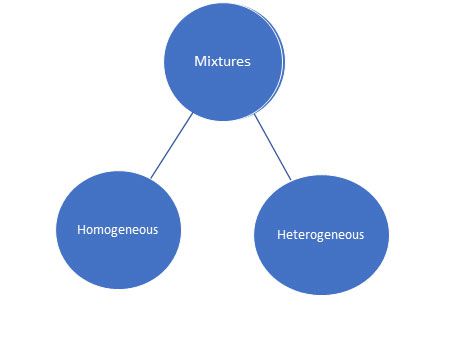Here the first question that arises is, what are compounds?
When two or more elements are combined chemically, then it is known as a compound. For example: – Hydrogen(H) and oxygen(O) are gases, but when combined chemically then they become water (H2O).
Compounds always have homogeneous compositions; for instance, we cannot spot the particles of oxygen and hydrogen in water. They can not be separated by any physical method; for example: – we cannot separate hydrogen(H) from oxygen(O) in water. Every compound has its chemical formula. An example of this can be water (H2O).
The compound has a fixed composition by mass. For example: – In a single molecule of water (H2O), there are two hydrogen atoms and one oxygen atom. If we increase the mass of the oxygen atom, it will become H2O2, and this is not a water molecule. Rather it is now a molecule of hydrogen peroxide. Compounds have fixed and sharp melting points.
One more example of compounds can be, when the elements of sodium (Na) and chlorine (Cl) combine, they form the compound, i.e. (that is) sodium chloride (NaCl) or, in simple terms, common salt.
So, now that we have an idea of compounds, let’s understand mixtures and mixtures and compounds differences.
Next comes, what are Mixtures?
A mixture combines two or more substances that are not chemically the same and do not chemically react together. A mixture has the same property as that of its component elements. It can be separated by physical means.
For example: – In the mixture of sugar and sand, even if we increase the volume of sugar or sand, the mixture remains the same. So, it implies that in a mixture, the components can be present in any proportion.
Also, mixtures have different compositions. This can be further explained by performing this experiment, taking a glass full of water, adding some mud, and stirring it well. We will obtain a mixture of the solid particles of mud dispersed in water.
Accordingly, Mixtures can be classified as homogeneous and heterogeneous.

What is a homogeneous mixture?
The word homo means “same”, thus a mixture that has a uniform composition throughout its homogeneous mass mixture. We cannot see or observe the particle of a homogeneous mixture with our naked eyes.
An example of a homogeneous mixture is when You mix table salt with a glass of water; then, you get a homogeneous mixture.
Remember that you cannot spot the particles or see the particles of salt and water, and we, therefore, call it a homogeneous mixture.
Another example can be air. We know that air is made up of different gases like oxygen, nitrogen, and carbon dioxide. Air is a homogeneous mixture because all these gases are combined physically to form a uniform composition throughout, and we cannot see the particles of these gases.
One last but not least example of a homogeneous mixture is alcohol, it also has a uniform composition throughout its mass, and we, therefore, call it a homogeneous mixture.
Now comes, what is a heterogeneous mixture?
A mixture that has non-uniform composition throughout its mass is known as a heterogeneous mixture. By non-uniform composition, we mean that we can see the particles of heterogeneous mixture with our naked eyes.
The best example of a heterogeneous mixture is salad; when you mix different vegetables physically, you get a salad. Secondly, you can easily recognise the ingredients of the salad.
The second example is oil and water; when we put some oil into the water, it is known as a heterogeneous mixture, we can recognise the layer of oil above the water.
The third example of a heterogeneous mixture is when we put small pebbles or sand into the water. It is called a heterogeneous mixture. We can easily spot the sand and water in it.
Remember that when we observe or see the particles of different substances within the mixture, we call it a heterogeneous mixture.
How to identify whether it is a homogeneous or heterogeneous mixture?
| Homogenous mixture | Heterogeneous mixture |
| These mixtures have uniform composition throughout their mass. | While heterogeneous mixture has non-uniform composition throughout their mass. |
| Here, there is no visible boundary of separation. Homogeneous mixtures are called solutions. E.g., sugar and salt solutions. | While in the heterogeneous mixture, there is a visible boundary of separation. While all the suspension and colloid are called heterogeneous mixtures. E.g., soap solution. |
| We cannot see particles in a homogeneous mixture with naked eyes. | We can see particles in a heterogeneous mixture with naked eyes. |
Mixtures and Compounds Differences
| Compound | Mixture |
| When two or more two elements combine chemically, it is known as a compound. E.g.- H + O = H2O (Water). | When two or more substances combine physically, it is known as a mixture. E.g.- copper (Cu) + tin (Sn) =Alloy. |
| Particles lose their original properties. E.g., hydrogen and oxygen are gases, but when combined chemically, their original Properties change and become water. | Particles retain their original properties. E.g., when we add pebbles to the water, both the pebbles and the water retain their original properties. |
| Compounds always have a homogeneous composition, and hence we cannot spot the particles of oxygen and hydrogen in the water. | Mixtures have either homogeneous or heterogeneous compositions. E.g., we can spot both pebbles and water in the mixture. |
| Components of compounds cannot be separated by physical method. E.g., we cannot separate hydrogen from oxygen by any physical means. | Components of the mixture can be separated by physical method. E.g. we can separate Pebbles from water by filtration. |
| Every compound has its chemical formula. E.g. the chemical formula of water is H2O. | The mixture has no chemical formula. E.g. sugar solutions have no chemical formula. |
| Compounds have fixed composition by mass. E.g., in a single molecule of water, there are two Hydrogen atoms and one oxygen atom; if we add one more oxygen atom, it becomes hydrogen peroxide. | The mixture has no fixed composition by mass. E.g., add sugar into water, we get a mixture. |
| Finally, compounds have fixed and sharp melting points. | The mixture does not have fixed and sharp melting points. |
Conclusion Therefore, we hope now you have a clear understanding between the different compounds and mixtures.

Namaste UI collaborates closely with clients to develop tailored guest posting strategies that align with their unique goals and target audiences. Their commitment to delivering high-quality, niche-specific content ensures that each guest post not only meets but exceeds the expectations of both clients and the hosting platforms. Connect with us on social media for the latest updates on guest posting trends, outreach strategies, and digital marketing tips. For any types of guest posting services, contact us on info[at]namasteui.com.

